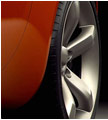CONTACT:
Charles Licari
810-986-0077
e-mail:
charles.licari@gm.com
July 18, 2000
WARREN, Mich. -- One clear lesson has emerged from General Motors' decades of industry-leading automotive safety research: The best way to avoid being injured is not to crash in the first place.
To that end, GM is in the midst of an automotive crash warning research project with the U.S. Department of Transportation and primary partner Delphi Delco Electronics Systems. Begun in the summer of 1999, the focus is on helping the driver be more intelligent about avoiding crashes by making the car smarter about the traffic and environment around it.
The first half of the five-year, $35 million Intelligent Vehicle Initiative (IVI) research project involves development and testing of prototype vehicles equipped with crash avoidance technology. GM and suppliers are currently working on a prototype car -- Buick LeSabre -- which should be complete in about a year. To show progress-to-date, GM is displaying a LeSabre engineering development vehicle equipped with collision warning system hardware at the U.S. Department of Transportation's IVI Conference in Washington, D.C. July 19-20.
The second half of the program will include the build of two pilot vehicles for further testing and validation, and a field test in Southeastern Michigan. Ten production Buick LeSabres outfitted with the system will be built in 2002 for real-world testing.
This will be the most comprehensive field test of automotive collision avoidance systems ever undertaken in the United States," said Dr. Lawrence D. Burns, vice president for GM Research & Development and Planning, the lead GM unit for the program. "Our belief is that the best crash protection we can provide is to help people avoid the collision altogether.
"No company has developed a sophisticated, multi-sensor collision warning system like this and then tested it in real-world conditions," Burns said. "We're understanding more and more the critical link between vehicle safety and driver behavior, and we're working to improve both."
A host of sensors and instruments on the car will measure road conditions and environmental factors and feed real-time information to decision-making software, which will alert the driver to hazards in the vehicle's forward path and adjust the car's adaptive cruise control. Once the system design and integration is complete, GM plans to turn over 10 test vehicles for selected members of the public to drive for 10 months in real-world conditions. Each of about 120 drivers would have unrestricted use of a test car for two to four weeks while data is collected. The University of Michigan Transportation Research Institute (UMTRI) would help screen, select and orient the drivers from across southeast Michigan, and then would perform data collection and analysis.
The LeSabres will be fitted with forward radar, forward vision, mapping systems, global positioning systems and adaptive cruise control, all tied together by sophisticated software and computers. The system even keeps tabs on what the driver is doing to estimate his or her "distraction level" and response times. When a threat is detected, the system will either alert the driver or, if adaptive cruise control is engaged, take control of the accelerator and brakes to slow down the vehicle.
Rear-end crashes account for more than one-fourth of all injury collisions, according to the U.S. Department of Transportation, and most are caused by inattention, tailgating or speeding - factors the U.S.-GM joint research project could alleviate.
If the driver's foot is on the brake or the car is moving less than 25 miles per hour, the collision-avoidance system will still be gathering and analyzing data, but will not report out any warnings. "If your foot's on the brake, you're paying attention," said Dr. Ronald Colgin, a staff research engineer at the GM Technical Center in Warren who is the program manager.
Other companies are experimenting with adaptive cruise control and simple collision avoidance systems that integrate a forward-looking laser or radar with a few sensors, but none has attempted the breadth and complexity of systems that the joint U.S.-GM research entails. Information streaming from more than 20 sensors and systems will be assessed and analyzed instantly by custom-built software.
Alerts and warnings from the system are based on the software's constant assessment of the potential for a crash.
"Our aim with this real-world study is to develop and integrate these technologies so that we can accelerate the introduction of a cohesive vehicle package with both forward collision warning and adaptive cruise control," Burns said.
The U.S. Department of Transportation is funding 61 percent of the program, with the remaining cost shared by GM and Delphi Automotive Systems.




